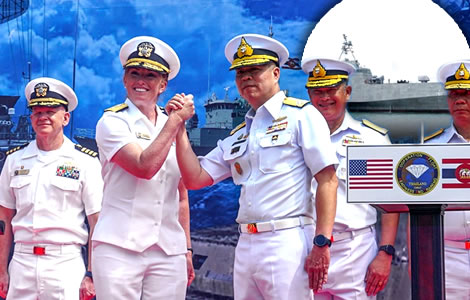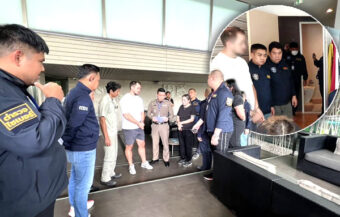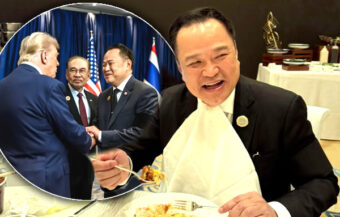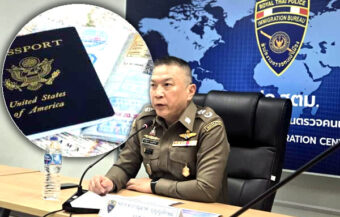The Thai, US, and Canadian navies launch 12-day CARAT drills in the Gulf of Thailand amid rising tensions with China. This 31st annual exercise enhances regional security, strengthens naval ties, and showcases joint readiness as Beijing’s assertiveness in the South China Sea and around Taiwan increases.
The Thai, U.S., and Canadian navies kicked off a 12-day joint military exercise on Monday, running from July 7 to 18 in the upper Gulf of Thailand. Now in its 31st year, the CARAT exercise marks a longstanding U.S. push to deepen naval ties with Southeast Asia since 1995. This year’s drills include the U.S. Marine Corps forces and come at a time of rising tensions in the region—especially over the South China Sea and Taiwan. With China’s assertiveness growing, the U.S. and its allies are stepping up their military posture in response.

Naval forces from the United States, Thailand, and Canada officially launched the 31st annual Cooperation Afloat Readiness and Training (CARAT) Thailand exercise on July 7. The opening ceremony took place at Laem Thian Pier in Sattahip District, Chonburi Province. As a result, this marked the beginning of 12 days of intensive joint naval training.
Rear Admiral Cathy F. Sheldon, Deputy Commander of the U.S. 7th Fleet, co-chaired the event on behalf of the United States. Meanwhile, Admiral Nataphol Diaovanich, Commander of the Royal Thai Fleet, presided over the Thai delegation. Together, their presence highlighted the importance of the long-standing partnership between the participating nations.
CARAT Thailand 2025 expands drills across provinces and adapts to evolving security needs in Indo-Pacific
The CARAT exercise runs from July 7 to July 18. It is held across Chonburi and Rayong provinces. Additionally, extensive drills will take place in the upper Gulf of Thailand. CARAT Thailand 2025 aims to boost naval cooperation, improve regional security and strengthen readiness in complex maritime environments.
Importantly, CARAT is the longest-running maritime exercise between the U.S. Navy and Southeast Asian navies. Since its start in 1995, the Royal Thai Navy has participated every year. Over time, the exercise has adapted to address new threats and evolving strategic needs in the Indo-Pacific.
This year, the U.S. Navy deployed the USS Santa Barbara (LCS-32), an Independence-class littoral combat ship. Specifically, it was sent to lead the U.S. contribution to the exercise. The vessel, under Lieutenant Commander Adam J. Ochs, is designed for operations in shallow coastal waters. It arrived at Chuk Samet Port on July 6. There, Captain Siriphop Thananantachoti of the Royal Thai Navy officially welcomed the ship and crew.
Aircraft, warships and Canadian boarding teams expand scope of regional cooperation and naval readiness
In addition, the U.S. Navy brought three types of aircraft. These include a P-8A Poseidon maritime patrol plane and an MH-60S Seahawk helicopter. Furthermore, the U.S. Marine Corps and the U.S. 7th Fleet Band joined the mission. Their presence supports both operations and community engagement efforts.
Meanwhile, the Royal Thai Navy assigned three ships to the exercise. These are HTMS Naresuan (FFG 421), HTMS Saiburi (FFG 458), and HTMS Rattanakosin (CVT 441). Each, with unique capabilities, will support different elements of the training. For example, frigates will focus on surface and air defence, while the corvette assists with patrol and escort missions.
Moreover, Canada is contributing a visit, board, search, and seizure (VBSS) team. The team will work closely with U.S. and Thai forces in complex boarding operations. This, in turn, reinforces Canada’s growing engagement in Indo-Pacific maritime cooperation.
As CARAT unfolds, the training is split into three key phases. First, the Shore Phase includes classroom learning and joint planning. Next, the Sea Phase features real-world drills in the Gulf of Thailand. Finally, an After-Action Review and closing ceremony will occur on July 16.
Drills focus on maritime combat, cultural exchange, and security cooperation among partner nations
According to Captain Matt Scarlett, commodore of Destroyer Squadron 7, this year’s CARAT emphasises joint capabilities. “We reaffirm our commitment to maritime security and regional stability,” Scarlett said. Clearly, joint operations with Thai and Canadian forces help build shared strength and trust.
Indeed, the maritime drills cover several advanced mission areas. These include anti-submarine warfare, air defence, and surface action group coordination. Additionally, mine countermeasures and search and rescue drills test the navies under realistic conditions.
Notably, CARAT Thailand is not limited to combat training. It also involves cultural and humanitarian activities. This year, crews will take part in a sports day, military band performances and local community service. Such efforts help foster deeper goodwill and understanding.
Admiral Diewvanich also emphasised the broader importance of the exercise. “CARAT promotes regional stability through cooperation and shared learning,” he stated. In particular, he highlighted the value of building experience and long-term trust.
Expert exchanges and Destroyer Squadron 7 leadership strengthen Indo-Pacific naval presence
Moreover, the exercise features expert-led classroom exchanges. These cover maritime domain awareness, medical support and ordnance disposal. These sessions, aimed at all ranks, ensure real knowledge transfer across partner forces.
Importantly, Destroyer Squadron 7 plays a key operational role. As the U.S. Navy’s forward-deployed squadron in Southeast Asia, it oversees littoral combat ships like the USS Santa Barbara. It operates under the U.S. 7th Fleet, the Navy’s largest forward-deployed fleet. As such, it routinely works with allies across the Indo-Pacific.
As regional dynamics shift, CARAT remains strategically relevant. Its core mission is to maintain a free and open Indo-Pacific. Therefore, strengthening partnerships and building naval capacity is essential.
Consequently, the presence of Canadian, Thai, and U.S. forces sends a strong message of unity. Their cooperation reflects a shared commitment to peace and mutual respect across the region.
Regional tension rises as China expands military footprint. CARAT builds trust through joint deterrence
Of course, CARAT Thailand 2025 showcases more than just military strength. It also highlights enduring partnerships and common security interests. With focused training and meaningful engagement, the exercise sets the tone for future cooperation.
US Navy in Sihanoukville on the Gulf of Thailand as Cambodia pivots towards warmer ties with America
China’s Navy sails into Ream Naval Base in Cambodia with Thailand’s neighbour now seen as a proxy for Beijing
Significantly, this year’s exercise comes amid rising regional tensions. Particularly, China’s claims in the South China Sea have raised international concern. It also coincides with U.S. alarm over growing naval cooperation between China, Cambodia, and Myanmar.
Concerns over tensions with China over the South China Sea and Taiwan have seen both U.S. and Western navies strengthening their posture in the region. This particularly includes the UK Royal Navy. In June, the British Royal Navy patrol vessel HMS Spey sailed through the Taiwan Strait, drawing an angry response from Beijing.
This is a key concern of the U.S. Pacific Fleet, which consists of some 200 ships, 1,500 aircraft and over 150,000 personnel. Their work is critical to preserving regional stability and, indeed, world peace.
In particular, there are worries nearer to home about the Siam Reap Naval Base, located near Sihanoukville on the Gulf of Thailand. The base is now home to the near-permanent presence of Chinese warships, while visiting foreign navies are excluded. These developments add urgency to regional exercises like CARAT.
Join the Thai News forum, follow Thai Examiner on Facebook here
Receive all our stories as they come out on Telegram here
Follow Thai Examiner here
Further reading:
US Navy in Sihanoukville on the Gulf of Thailand as Cambodia pivots towards warmer ties with America
Move Forward opposes any plan to allow a US base in Thailand and commits to uphold its sovereignty
Ironclad partnership heralded as Marcos visits Washington amid raised South China Sea tensions
Chinese Foreign Minister tells world elite in Shanghai of a ‘new form of human advancement’ in China
Sub call due soon but closer ties between Chinese and Thai navies signalled by top-level visit
China’s new foreign minister warns of certain US-Chinese war if Washington fails to reverse course
War with China is a rising spectre that must be confronted as US General predicts conflict by 2025
Heat turned up over the Sukhothai naval tragedy with 19 thought to have perished and 10 missing
Bad news from Beijing with Xi’s rise, the prospect of war and a divided world have greatly grown
Abe’s legacy will be his efforts to awaken Japan and build a defensive alliance against China
Former Pheu Thai finance minister expresses unease about US regional moves to counter China’s rise
Thailand and Japan announce defence pact on visit by Japanese PM to Bangkok ahead of US summit


















